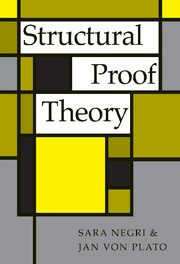Book contents
- Frontmatter
- Contents
- PREFACE
- INTRODUCTION
- 1 FROM NATURAL DEDUCTION TO SEQUENT CALCULUS
- 2 SEQUENT CALCULUS FOR INTUITIONISTIC LOGIC
- 3 SEQUENT CALCULUS FOR INTUITIONISTIC LOGIC
- 4 THE QUANTIFIERS
- 5 VARIANTS OF SEQUENT CALCULI
- 6 STRUCTURAL PROOF ANALYSIS OF AXIOMATIC THEORIES
- 7 INTERMEDIATE LOGICAL SYSTEMS
- 8 BACK TO NATURAL DEDUCTION
- CONCLUSION: DIVERSITY AND UNITY IN STRUCTURAL PROOF THEORY
- APPENDIX A SIMPLE TYPE THEORY AND CATEGORIAL GRAMMAR
- APPENDIX B PROOF THEORY AND CONSTRUCTIVE TYPE THEORY
- APPENDIX C PESCA – A PROOF EDITOR FOR SEQUENT CALCULUS (by Aarne Ranta)
- BIBLIOGRAPHY
- AUTHOR INDEX
- SUBJECT INDEX
- INDEX OF LOGICAL SYSTEMS
6 - STRUCTURAL PROOF ANALYSIS OF AXIOMATIC THEORIES
Published online by Cambridge University Press: 25 February 2010
- Frontmatter
- Contents
- PREFACE
- INTRODUCTION
- 1 FROM NATURAL DEDUCTION TO SEQUENT CALCULUS
- 2 SEQUENT CALCULUS FOR INTUITIONISTIC LOGIC
- 3 SEQUENT CALCULUS FOR INTUITIONISTIC LOGIC
- 4 THE QUANTIFIERS
- 5 VARIANTS OF SEQUENT CALCULI
- 6 STRUCTURAL PROOF ANALYSIS OF AXIOMATIC THEORIES
- 7 INTERMEDIATE LOGICAL SYSTEMS
- 8 BACK TO NATURAL DEDUCTION
- CONCLUSION: DIVERSITY AND UNITY IN STRUCTURAL PROOF THEORY
- APPENDIX A SIMPLE TYPE THEORY AND CATEGORIAL GRAMMAR
- APPENDIX B PROOF THEORY AND CONSTRUCTIVE TYPE THEORY
- APPENDIX C PESCA – A PROOF EDITOR FOR SEQUENT CALCULUS (by Aarne Ranta)
- BIBLIOGRAPHY
- AUTHOR INDEX
- SUBJECT INDEX
- INDEX OF LOGICAL SYSTEMS
Summary
In this chapter, we give a method of adding axioms to sequent calculus, in the form of nonlogical rules of inference. When formulated in a suitable way, cut elimination will not be lost by such addition. By the conversion of axioms into rules, it becomes possible to prove properties of systems by induction on the height of derivations.
The method of extension by nonlogical rules works uniformly for systems
based on classical logic. For constructive systems, there will be some special forms
of axioms, notably (P ⊃ Q) ⊃ R, that cannot be treated through cut-free rules.
In the conversion of axiom systems into systems with nonlogical rules, the multisuccedent calculi G3im and G3c are most useful. All structural rules will be admissible in extensions of these calculi, which has profound consequences for the structure of derivations. The first application is a cut-free system of predicate logic with equality. In earlier systems, cut was reduced to cuts on atomic formulas in instances of the equality axioms, but by the method of this chapter, there will be no cuts anywhere. Other applications of the structural proof analysis of mathematical theories include elementary theories of equality and apartness, order and lattices, and elementary geometry.
FROM AXIOMS TO RULES
When classical logic is used, all free-variable axioms (purely universal axioms) can be turned into rules of inference that permit cut elimination. The constructive case is more complicated, and we shall deal with it first.
- Type
- Chapter
- Information
- Structural Proof Theory , pp. 126 - 155Publisher: Cambridge University PressPrint publication year: 2001



